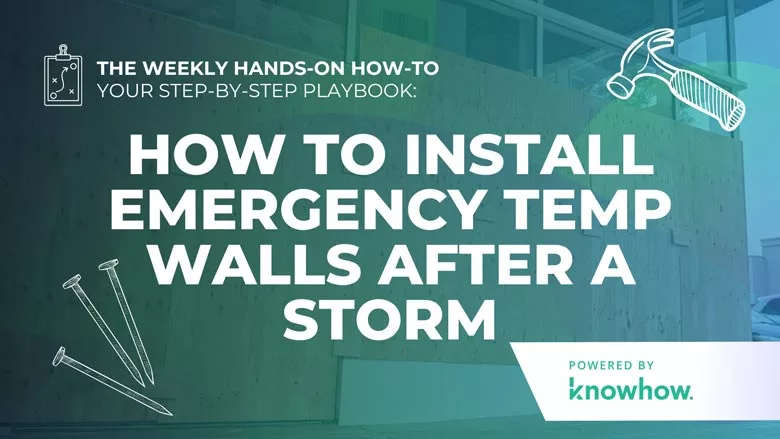Weekly Hands-on How-To powered by KnowHow
How To Install Emergency Temp Walls after a Storm
Essential Guide for Installing Temporary Walls Post-Storm: Tips for Effective Recovery

All images provided by KnowHow
After a storm hits, broken windows, collapsed walls, and exposed interiors leave homes and businesses wide open to the elements. This is when the clock starts ticking, because left unchecked, these vulnerabilities will lead to water infiltration, structural instability, and mold growth. That’s where temporary walls come in—providing the first critical line of defense.
Whether it’s shielding against the elements or stabilizing a structure during demolition, temporary walls are essential in post-storm recovery. But building them takes more than just putting up some plywood—it requires a step-by-step approach and the right techniques. In this guide, powered by KnowHow, we’ll walk you through how to construct strong, reliable temporary walls to protect properties and keep recovery efforts on track.
But before we dive into the process, let’s explore why these walls are so important, and the different types of temporary walls that you’ll be using.
The Role of Temporary Walls in Post-Storm Recovery
Temporary walls are essential in post-storm recovery. They provide immediate protection against environmental elements like wind, rain, and debris, safeguarding damaged areas from further deterioration. These walls also help maintain privacy, prevent unauthorized access, and create a controlled work environment.
But not all temporary walls are the same. Depending on the situation, different types of walls serve specific purposes. Let’s explore the key considerations for both interior and exterior temporary walls.
- Interior Temporary Walls for Demo Support: In demolition scenarios, interior temporary walls play a vital role in stabilizing the structure and protecting workers. Constructed from materials like plywood or metal studs, these walls provide crucial bracing to support the building’s weight during demolition work, ensuring the safety of everyone on-site.
- Maintaining Structural Integrity with Interior Walls: To effectively preserve structural integrity, interior temporary walls should be securely anchored to floor and ceiling joists. Regular inspections are key to identifying and addressing any signs of weakness, reducing risks during extended restoration projects and maintaining the overall stability of the site.
- Preserving Exterior Temporary Walls Against the Elements: Exterior temporary walls must endure harsh weather conditions. Using durable, weather-resistant materials like metal panels, combined with thorough sealing of joints and edges, ensures these walls can withstand rain and wind. Regular inspections and reinforcements are necessary to maintain their protective capabilities over time.
So, how do you set these up to ensure optimal protection? Let’s walk through the step-by-step process for installing temporary walls effectively.
Note: This Weekly Hands-On How-To was based on this template in KnowHow’s template library.
Step 1: Assess the Damage
Start by conducting a thorough inspection of the site to identify areas impacted by the storm. Pay close attention to structural weaknesses, water intrusion, and compromised sections that will need temporary wall support. Document these findings to guide the installation process and prioritize areas requiring immediate attention.
Key Areas to Inspect:
- Roofline and Walls: Look for missing or damaged panels, sagging areas, and signs of compromised support beams.
- Foundation: Check for cracks, shifts, or erosion that could undermine the stability of the structure.
- Openings and Gaps: Identify large breaches, including broken windows, doors, and wall sections, where temporary walls are critical for protection.
Hazards to Watch For:
- Unstable Surfaces: Look for loose debris, uneven flooring, or weakened areas that could collapse underfoot.
- Water Pooling: Standing water can weaken structures and pose electrical risks.
- Exposed Wiring and Sharp Objects: Ensure these hazards are flagged to prevent injury during the installation process.

Step 2: Measure the Space
Accurate measurements ensure that your temporary wall materials will fit correctly. Use a measuring tape or laser tool to capture the dimensions of the damaged area, taking irregularities like pipes, window frame, or protrusion into account. This will help you cut materials to the proper size.
Step 3: Gather Materials
With your measurements in hand, gather all the tools and materials you’ll need. Be sure everything is in good working condition before starting the job.
Essential Materials and Tools:
- Wall Panels: Plywood or metal for strong, durable coverage.
- Support Beams: Ensure structural stability.
- Fasteners: Screws, nails, brackets.
- Tools: Drill, hammer, measuring tape, level.
- Safety Gear: Gloves, goggles, harnesses.
Organize your supplies at the site for easy access and efficiency.
Step 4: Install Support Beams
Support beams form the backbone of your temporary wall system, ensuring stability and strength. Position sturdy vertical beams where the temporary wall will be erected. Use a level to ensure they’re aligned and securely anchor them to the floor or existing structures with screws and brackets.
- Position Beams: Place them vertically along the damaged area, ensuring proper spacing.
- Secure to Existing Structures: Use screws and brackets to anchor beams to walls or the ground.
- Check Alignment: Ensure beams are plumb and sturdy.

Step 5: Install Panels
Once the support beams are in place, it’s time to attach the panels to the support beams. Precision is key here—each panel must be properly aligned and securely fastened to create a sturdy temporary barrier. Taking the time to get this right ensures the structure remains stable and weather-resistant throughout the recovery process.
- Align Panels: Position the panels flush against the support beams for a seamless fit.
- Fasten Securely: Use screws or nails to attach each panel firmly to the beams, ensuring no gaps or loose edges.
- Double-Check Stability: Verify that all panels are evenly spaced and securely fastened to maintain overall stability.
Repeat until the entire damaged area is covered.
Step 6: Seal Any Gaps
Even the best panel installation can leave small gaps or cracks. Inspect the installed panels for gaps or holes, especially at the joints. Use caulking or sealant to close these spaces, providing a weather-resistant barrier that prevents water infiltration.
Step 7: Secure the Walls
Double-check that all panels and support beams are tightly fastened. Reinforce the structure with additional bracing if necessary, ensuring it can withstand adverse weather conditions.
- Check Fasteners: Ensure all screws and nails are tight.
- Add Bracing: Use additional beams or braces for extra stability if needed.
- Conduct a Stability Test: Push gently on different sections to confirm sturdiness.
Build Better with KnowHow
Temporary walls are a critical step in post-storm recovery, offering immediate protection and stability when structures are at their most vulnerable. However, building them correctly requires precision, planning, and a thorough understanding of best practices.
But every job is different, and keeping track of every detail—from materials required to proper techniques—can be a challenge. That’s where KnowHow makes all the difference. By providing your crews with instant access to your company’s SOPs, step-by-step guides, and instant on-site answers, KnowHow empowers your crew to make informed decisions without endless calls to managers. Visit tryknowhow.com to learn more.
Looking for a reprint of this article?
From high-res PDFs to custom plaques, order your copy today!







